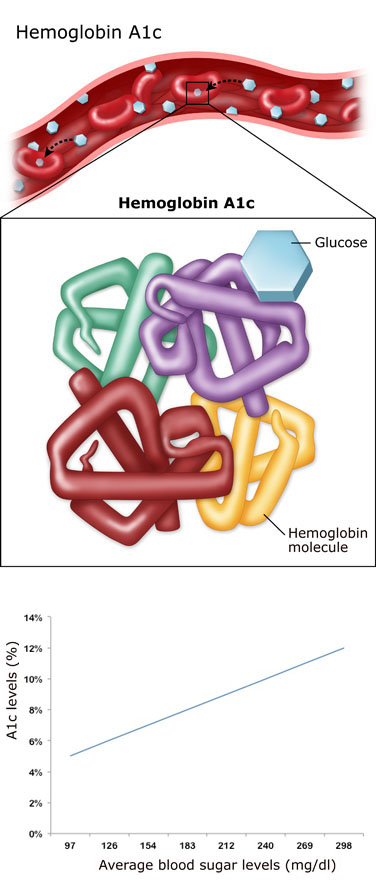Glysolated Hemoglobin (or A1c) is a measure of your average blood glucose control over the previous three months.
Glucose attaches to hemoglobin the oxygen carrying molecule in red blood cells. The glucose-hemoglobin unit is called glycosylated hemoglobin. As red blood cells live an average of three months, the glycosylated hemoglobin reflects the glucose exposure to the cells over that time.

The higher the amount of glucose in the blood, the higher the percentage of hemoglobin molecules that will have glucose attached. Think of the A1c as a long-term blood glucose measure that changes very gradually as red blood cells die and are replaced by new cells.
The A1c doesn’t replace self blood-glucose monitoring. Because the A1c is an average of all your blood glucose, it does not tell you your blood glucose patterns. For example, one person with frequent highs and lows can have the same A1c as another person with very stable blood glucose levels that don’t vary too much.
So what’s the point?
A1c is yet another indicator of how well you’re doing.
- An A1c measurement between 4- 5.6 % is considered the range that someone without Diabetes will have.
- An A1c measurement between 5.7% and 6.4% is the range considered for Prediabetes.
- Diabetes may be diaganosed with an A1c of 6.5% or above.
- Once you have Diabetes, the American Diabetes Association goal is an A1c less than 7%. Research has shown that an A1c less than 7% lowers risk for complications.
- For some people with Diabetes an A1c goal of less than 6% is appropriate.
- Talk with your doctor about your A1c goal.
- Hemoglobin A1C between 7 and 8 % may appropriate given certain circumstance, discuss this with your medical provider.
- If you are using a continuous glucose monitor (CGM), time in target is another way to assess your overall glucose optimization.
A1c values and comparable blood glucose values

A note of caution: the A1c measurement is not always accurate. For example, if someone has certain type of hemoglobin mutations (variation in the hemoglobin structure), is severely anemic (low red blood cell count), iron deficient or is being treated blood transfusions or medications to increase the production of new red blood cells, the A1c test may not be accurate.
If your finger-stick blood tests give an average blood glucose that is much higher or lower than your A1c test, ask your doctor if the A1c is the right test for you. An alternative test to the A1c is a fructosamine test. Unfortunately, the fructosamine test and the A1c are not interchangeable because they measure different things. The fructosamine test reflects the average blood glucose levels only over a 2-3 week period. Lastly, discuss with your provider whether continuous glucose monitoring may be appropriate for you.